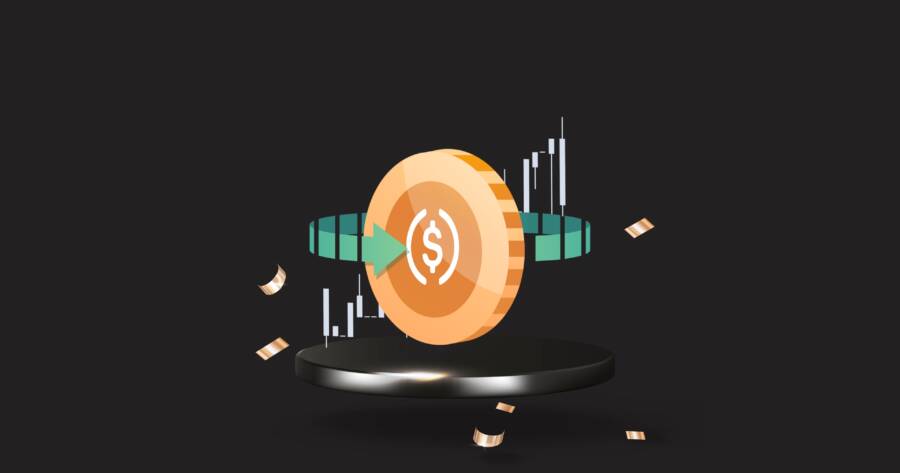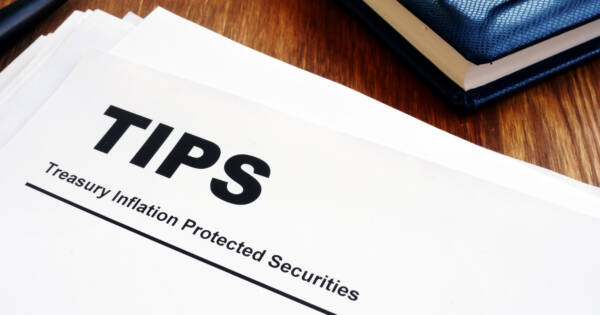In the year 2021, the price of Bitcoin has gone up and down by tens of thousands of dollars. This type of volatility can be attractive to those looking to make a quick buck by buying the dip. However, for many conservative investors, this behavior has made getting into cryptocurrency a non-starter. If you fall into this category too, the good news is that there is a type of crypto built just for you.
The aptly named “stablecoins” are a class of cryptocurrencies whose value is pegged to an underlying asset. This asset is often something like U.S. dollars or gold, although it can also be other cryptocurrencies. Take One USD Coin, for example. It’s a stablecoin created by crypto exchange Coinbase. It’s worth, as the name implies, is exactly $1 USD. The goal of stablecoins are to provide consumers with a cryptocurrency whose value doesn’t fluctuate based on tweets from Elon Musk.
So, stablecoins are designed to be stable. Seems obvious enough, right? But does that make them worth investing in?
The Basics: Types of Stablecoins
Most stablecoins are backed by physical currencies, such as the U.S. dollar. Some are backed by other assets denominated in physical currencies. The aforementioned USD Coin (along with Binance USD and Tether — two other popular stablecoins) fall into this category. However, some stablecoins, like Dai, are backed by other forms of crypto.
There are also stablecoins whose value is backed by assets. The value of PAX Gold is backed by actual gold. Some stablecoins are not backed by any assets at all, but have their value controlled via an algorithm, like AMPL. The creators of AMPL increase or decrease the supply of the coin daily to maintain its peg with the dollar.
Knowing what a stablecoin is backed by is important. For example, the value of a stablecoin backed by the dollar could change if the dollar itself lost value. The same could happen with a gold-backed coin, too. Meanwhile, holders of coins like AMPL will see their total holdings increase or decrease daily. The percentage of AMPL they own will not change, though, just the total amount in circulation.
The Basics: Market Cap
According to NerdWallet, as of October 2021, the top ten stablecoins by market capitalization have a total value of approximately $126.9 billion. This may sound like a lot. However, for reference, the total market cap of Bitcoin is $1.06 trillion. The stablecoin with the highest market capitalization is Tether, at $68.2 billion.
A cryptocurrency’s market capitalization can tell you a few things. First, it’s a gauge of overall investor interest. A higher cap generally means more interest. Second, it can tell you how susceptible a coin is to a massive sell-off. Higher-cap coins are generally able to more easily rebound from such events. For stablecoins, market cap indicates both popularity and, in theory, the value of the assets the company issuing it has in reserve.
The Basics: Purchasing Stablecoins
Stablecoins can be purchased on numerous cryptocurrency exchanges or from the exchange or company that issues them. For example, you can buy Tether on Coinbase or on Tether’s website. Creating an account on these exchanges is typically free. New users are sometimes rewarded with free crypto, too.
Once purchased, your stablecoin will either be held in the exchange’s digital wallet or your own personal digital wallet. It’s important to note that most stablecoins are worth around $1 apiece. That means if you see an exchange selling stablecoins for more than that, you should definitely research the coin before buying it.
 Shutterstock
ShutterstockThe Basics: Spending Stablecoins
Companies are slowly starting to accept some cryptocurrencies as payment. However, the same cannot be said for stablecoins. Instead, most stablecoin holders merely use them to purchase other types of crypto. Some exchanges even require users to buy crypto using their own stablecoins.
Relatively few major companies, if any at all, accept stablecoins as payment. However, they can still be used for private transactions. Some online merchants may even prefer to be paid in stablecoins. This is because they won’t be subject to credit card processing or currency conversion fees.
Profiting From Stablecoins: Earning Interest
Stablecoin holders can earn interest on their investment by lending it out to crypto platforms. The process is similar to a savings account, in that your deposit earns interest. However, the interest is much higher than what any bank would ever offer. Crypto bank BlockFi is currently offering 8.25% interest on USD Coin and Binance USD deposits of between 0 and 40,000 coins. The interest is paid out monthly and compounds.
These rates are close to the average rate of return from the stock market, which is traditionally 10%. However, like high-yield savings accounts, the rate of return from a crypto savings account fluctuates. Investors need to keep an eye on the rates offered at various crypto banks to ensure maximum returns.
Profiting From Stablecoins: The Underlying Asset Value
Stablecoins pegged to the prices of assets can increase in value much quicker than those pegged to world currencies. For example, one PAX Gold token is backed by one fine troy ounce of gold. When the price of gold goes up, so too does the value of PAX Gold.
Stablecoins pegged to the value of a physical good can offer quicker return on investment than those pegged to the dollar. However, investors must pay close attention to the commodity their coin is backed by in order to turn a profit.
Profiting From Stablecoins: Staking
Like lending your stablecoins to a crypto bank, staking is another way to earn interest from your holdings. Staking basically means lending your stablecoins to an exchange to be used as collateral for crypto transactions. Unlike a crypto savings account, staking works similarly to a Certificate of Deposit issued by a bank. You will not be able to touch your coins until the prescribed loan period has ended.
Staking is another way to earn a steady income from stablecoins. Like with a crypto savings account, investors should shop around to find the best rates available.
Stablecoin Risks: Lack of Depositor Insurance
Despite the fact that many stablecoins are pegged to the dollar, there is no federal deposit insurance offered for them. In 2019, the New York Attorney General found that Tether did not have the reserves to back the stablecoins it issued. Tether was actually banned from conducting business in New York because of this.
This lack of reserves represents a major risk for investors. Exchanges may freeze withdrawals if there is a run on their stablecoin. Hefty fines or costly hacks might also make stablecoin issuers freeze withdrawals, as these eat into their liquidity. A lack of federal deposit insurance means that stablecoin holders may not always be able to make withdrawals. This could present a major risk for those with substantial holdings.
Stablecoin Risks: Hackers
Yes, stablecoins can be stolen — just like other forms of cryptocurrency. In the event of a hack, the only hope is for the exchange or coin issuer to make investors whole. Depending on the scale of the hack, this can be difficult to do. Even if a full refund is possible, it’s likely to take a significant amount of time. Crypto hacks aren’t that rare, either. In the first half of 2021, $361 million was stolen from decentralized financial institutions that deal in crypto.
Unlike a bank, many of the crypto platforms that offer interest-based products don’t offer depositor insurance. This makes hackers a real threat to stablecoin investors.
Stablecoin Risks: The Underlying Asset
The very thing that makes stablecoins appealing can also make them risky to investors. Simply put, the value of a stablecoin is determined by the asset that backs it. This is a problem for asset-backed stablecoins, as they actually lose value. Currency-backed coins, on the other hand, simply lose purchasing power.
This is admittedly not as big a problem as the threat of hackers or a liquidity crisis. Still, it represents a risk nonetheless — one that shouldn’t be ignored. This is especially true for commodity-backed stablecoins.
 Shutterstock
ShutterstockStablecoin Risks: Fraud
Cryptocurrency is still the Wild West of finance. Stablecoins are no exception. Fraudulent exchanges exist and their plan of attack is incredibly simple. Once you sign up and deposit your money, there is no way to withdraw it. Or the exchange simply stops operating one day and does what’s known as a “rug pull” on users.
How big is the risk? From October 2020 to August 2021, Americans lost $80 million to crypto scammers. Just because an exchange is offering a stablecoin doesn’t make it legitimate. Just because a company offers a digital wallet does not make it legitimate. When it comes to crypto, even stablecoins, do your research before depositing any of your money.
Stablecoin Risks: Not Truly Decentralized
Unlike with Bitcoin, Ethereum, Dogecoin, and other popular forms of crypto, the price of a stablecoin is not set by the market. This is good when it comes to maintaining the value of a stablecoin. However, it also gives the issuer of the stablecoin an incredible amount of power.
Stablecoin holders can do nothing to stop its issuers from changing the coin’s value. The same is true for crypto banks and staking platforms. There is no government authority or central bank regulating interest rates or setting guidance for them. That means that, despite their name, stablecoins may not actually be all that stable. These coins may be more stable than Bitcoin, but that’s not exactly a high car. That stability is only ensured by a unregulated issuer or institution.
The Bottom Line
Despite their name, investing in stablecoins still carries plenty of risk. The return on investment may not actually beat out what you’d make in the stock market, either. That being said, stablecoins are a solid option for those who want to dip their toes into crypto. Their value doesn’t swing wildly. The primary ways to profit from them are modeled off of traditional financial products too. This makes them both futuristic and familiar, offering a nice balance to crypto newcomers.








